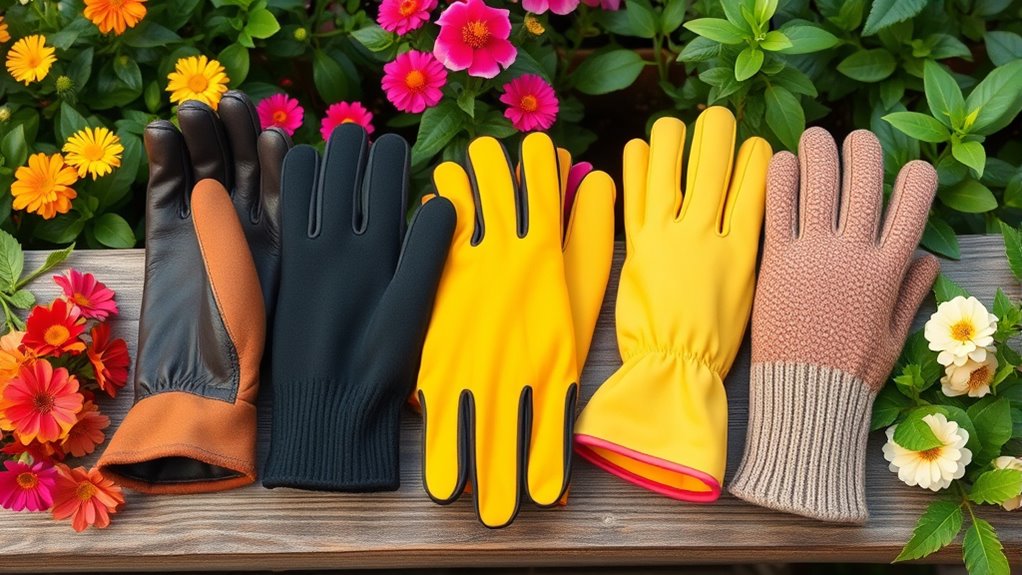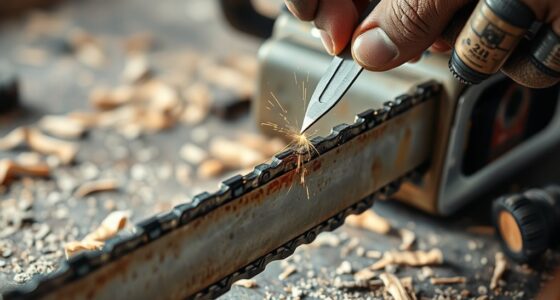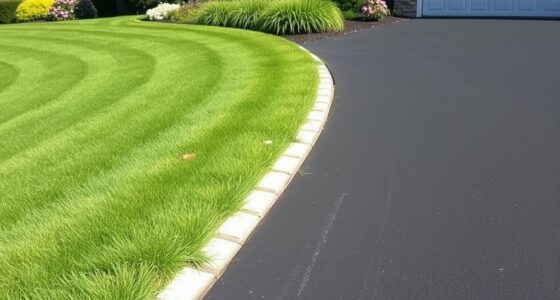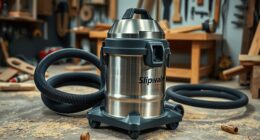To choose garden gloves for different tasks, match the material to the job’s demands—thin, breathable fabrics like nylon are great for delicate work, while thicker leather or rubber provides better protection for tough chores. Confirm the gloves fit snugly without restricting movement, and look for features like reinforced fingertips or adjustable cuffs for added comfort and durability. Keep these tips in mind, and you’ll discover more ways to select the perfect gloves for every gardening task.
Key Takeaways
- Match glove material to task: use lightweight, breathable fabrics for delicate work and sturdy materials like leather for heavy-duty tasks.
- Ensure proper fit by measuring hand circumference and trying different brands to prevent discomfort and improve safety.
- Consider design features such as reinforced fingertips and adjustable cuffs for durability and better protection.
- Select gloves with appropriate breathability and moisture-wicking properties to maintain comfort during prolonged use.
- Prioritize safety and efficiency by choosing gloves that combine the right material, fit, and features for each gardening activity.

Picking the right garden gloves is vital for protecting your hands and making gardening easier. When selecting gloves, one of the most important factors to think about is the glove material. Different materials offer various benefits depending on the task at hand. For light work like planting seeds or handling delicate flowers, you might prefer thin, breathable fabrics such as nylon or polyester, which give you dexterity and comfort. For tougher tasks like digging or handling thorny bushes, thicker materials like leather or rubber provide better protection against cuts and abrasions. Synthetic blends can also be a good choice—they often combine flexibility with durability, making them versatile for multiple gardening chores. No matter what material you choose, make sure it’s suited to the specific job to avoid unnecessary discomfort or risk of injury. Additionally, considering gloves with odor control features can help keep your hands fresh during extended gardening sessions.
Fit and sizing are equally vital. Ill-fitting gloves can hinder your work and even cause blisters or discomfort. When trying on gloves, make certain they fit snugly but aren’t too tight. You should have enough room to move your fingers freely without feeling constricted. Proper fit also means the gloves stay securely in place as you work—loose gloves can slip and lead to accidents or drop tools. Many brands offer sizing charts, so measure your hand’s circumference around the widest part of your palm to determine your size accurately. Some gloves come in small, medium, large, or extra-large, so check the sizing guide before purchasing. Remember, a well-fitting glove enhances both safety and efficiency, allowing you to grip tools firmly and perform tasks with greater precision. It’s worth trying different brands or styles to find the perfect fit for your hand shape.
In addition to material and fit, consider the glove’s overall design. Features like reinforced fingertips, adjustable cuffs, and breathable panels can make a big difference in comfort and usability. For example, gloves with adjustable wrists help keep dirt and debris out, while reinforced areas extend the lifespan of the gloves—especially if you’re doing heavy-duty work. Breathability matters if you tend to sweat, as it keeps your hands dry and reduces discomfort. Ultimately, choosing gloves that strike the right balance between material, fit, and features will make your gardening experience safer and more enjoyable. Take the time to evaluate your needs for each task, and don’t be afraid to try different options until you find the perfect pair. Properly fitted, suitable gloves will protect your hands and improve your gardening efficiency notably.
Frequently Asked Questions
Are Waterproof Gloves Suitable for All Gardening Tasks?
Waterproof gloves aren’t suitable for all gardening tasks. While they’re great for watering gloves or working in wet conditions, they might not be ideal for tasks like pruning or handling thorny plants, where leather garden gloves offer better protection and flexibility. Waterproof gloves can cause sweating and reduce dexterity over time, so choosing the right gloves depends on the task. Always select gloves that provide the right balance of protection and comfort.
How Do I Prevent Gloves From Slipping During Use?
To prevent gloves from slipping during use, focus on improving glove grip and slip prevention. Choose gloves with textured or rubberized palms, which increase friction and hold onto tools better. Make sure your gloves fit snugly but comfortably, as loose gloves tend to slip. Keep your gloves clean and dry, since moisture reduces grip. Regularly check for wear and replace them when the grip starts to fade, ensuring safer, more secure handling.
Can I Use the Same Gloves for Both Pruning and Planting?
You can use the same gloves for pruning and planting if they have versatile features, but keep in mind glove material differences. Pruning gloves often have thicker, more durable materials like leather to protect against thorns, while planting gloves are usually lighter with features like grip-enhancing coatings. Task-specific glove features, such as cut resistance or flexibility, help you choose the right gloves for each activity, ensuring safety and comfort.
What Are the Best Gloves for Allergy-Sensitive Gardeners?
If you have allergy sensitivity, look for garden gloves made from hypoallergenic materials. These gloves help protect your sensitive skin from irritants and allergens commonly found in gardening environments. Choose gloves with seamless designs or soft linings to prevent chafing and skin reactions. Always check labels for allergy-friendly features, and consider investing in gloves that offer both durability and sensitive skin protection, ensuring comfortable, safe gardening experiences.
How Should I Care for and Clean My Gardening Gloves?
To keep your gardening gloves in top shape, focus on glove material maintenance by cleaning them regularly with mild soap and water or following manufacturer instructions. Make sure they’re completely dry before storage. Store your gloves in a cool, dry place, following best practices for storage. This prevents mold and damage, extends their lifespan, and ensures they’re ready for your next gardening session. Proper care keeps your gloves comfortable and effective.
Conclusion
Just like a trusted shield protects a knight, the right garden gloves safeguard your hands through every task. Think of each pair as a tool in your gardening arsenal—strong for tough work, flexible for delicate tasks. When you choose wisely, you’re equipping yourself with armor that makes gardening safer and more enjoyable. Remember, the right gloves aren’t just protection—they’re your trusty companions, helping you conquer every gardening adventure with confidence and care.









